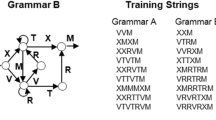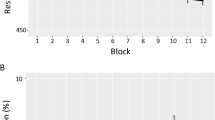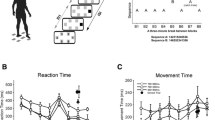Abstract
In the serial reaction time task (SRTT), a sequence of visuo-spatial cues instructs subjects to perform a sequence of movements which follow a repeating pattern. Though motor responses are known to support implicit sequence learning in this task, the goal of the present experiments is to determine whether observation of the sequence of cues alone can also yield evidence of implicit sequence learning. This question has been difficult to answer because in previous research, performance improvements which appeared to be due to implicit perceptual sequence learning could also be due to spontaneous increases in explicit knowledge of the sequence. The present experiments use probabilistic sequences to prevent the spontaneous development of explicit awareness. They include a training phase, during which half of the subjects observe and the other half respond, followed by a transfer phase in which everyone responds. Results show that observation alone can support sequence learning, which translates at transfer into equivalent performance as that of a group who made motor responses during training. However, perceptual learning or its expression is sensitive to changes in target colors, and its expression is impaired by concurrent explicit search. Motor-response based learning is not affected by these manipulations. Thus, observation alone can support implicit sequence learning, even of higher order probabilistic sequences. However, perceptual learning can be prevented or concealed by variations of stimuli or task demands.








Similar content being viewed by others
References
Dennis NA, Howard JH Jr, Howard DV (2006) Implicit sequence learning without motor sequencing in young and old adults. Exp Brain Res 175:153–164
Deroost N, Soetens E (2006a) Perceptual or motor learning in SRT tasks with complex sequence structures. Psychol Res 70:88–102
Deroost N, Soetens E (2006b) Spatial processing and perceptual sequence learning in SRT tasks. Exp Psychol 53:16–30
Frensch PA (1998) One concept, multiple meanings: on how to define the concept of implicit learning. In: Stadler MA, Frensch PA (eds) Handbook of implicit learning. Sage Publications Inc, Thousand Oaks, pp 47–104
Frensch PA, Lin J, Buchner A (1998) Learning versus behavioral expression of the learned: The effects of a secondary tone-counting task on implicit learning in the serial reaction task. Psychol Res 61:83–98
Howard JH Jr, Howard DV (1997) Age differences in implicit learning of higher order dependencies in serial patterns. Psychol Aging 12:634–656
Howard DV, Howard JH Jr (2001) When it does hurt to try: adult age differences in the effects of instructions on implicit pattern learning. Psychon Bull Rev 8:798–805
Howard JH Jr, Mutter SA, Howard DV (1992) Serial pattern learning by event observation. J Exp Psychol Learn Mem Cogn 18:1029–1039
Howard DV, Howard JH Jr, Japikse K, DiYanni C, Thompson A, Somberg R (2004) Implicit sequence learning: effects of level of structure, adult age, and extended practice. Psychol Aging 19:79–92
Japikse K, Howard DV, Howard JH Jr (2001) Evaluation of a direct nonverbal measure of declarative sequence knowledge. J Cogn Neurosci Suppl 12:62
Jimenez L, Vaquero JM, Lupianez J (2006) Qualitative differences between implicit and explicit sequence learning. J Exp Psychol Learn Mem Cogn 32:475–490
Kelly SW, Burton AM (2001) Learning complex sequences: no role for observation? Psychol Res 65:15–23
Knee R, Thomason S, Ashe J, Willingham DT (2007) The representation of explicit motor sequence knowledge. Mem Cogn 35:326–333
Mayr U (1996) Spatial attention and implicit sequence learning: evidence for independent learning of spatial and nonspatial sequences. J Exp Psychol Learn Mem Cogn 22:350–364
Nissen MJ, Bullemer P (1987) Attentional requirements of learning: evidence from performance measures. Cogn Psychol 19:1–32
Remillard G (2003) Pure perceptual-based sequence learning. J Exp Psychol Learn Mem Cogn 29:581–597
Remillard G, Clark JM (2001) Implicit learning of first-, second-, and third-order transition probabilities. J Exp Psychol Learn Mem Cogn 27:483–498
Robertson EM (2007) The serial reaction time task: implicit motor skill learning? J Neurosci 27:10073–10075
Robertson EM, Pascual-Leone A (2001) Aspects of sensory guidance in sequence learning. Exp Brain Res 137:336–345
Robertson EM, Tormos JM, Maeda F, Pascual-Leone A (2001) The role of the dorsolateral prefrontal cortex during sequence learning is specific for spatial information. Cereb Cortex 11:628–635
Rüsseler J, Rösler F (2000) Implicit and explicit learning of event sequences: evidence for distinct coding of perceptual and motor representations. Acta Psychol (Amst) 104:45–67
Rüsseler J, Munte TF, Rösler F (2002) Influence of stimulus distance in implicit learning of spatial and nonspatial event sequences. Percept Mot Skills 95:973–987
Rüsseler J, Hennighausen E, Münte TF, Rösler F (2003) Differences in incidental and intentional learning of sensorimotor sequences as revealed by event-related brain potentials. Cogn Brain Res 15:116–126
Schvaneveldt RW, Gomez RL (1998) Attention and probabilistic sequence learning. Psychol Res 61:175–190
Song S, Howard JH Jr, Howard DV (2007) Implicit probabilistic sequence learning is independent of explicit awareness. Learn Mem 14:167–176
Willingham DB (1999) Implicit motor sequence learning is not purely perceptual. Mem Cogn 27:561–572
Willingham DB, Goedert-Eschmann K (1999) The relation between implicit and explicit learning: evidence for parallel development. Psychol Sci 10:531–534
Willingham DB, Nissen MJ, Bullemer P (1989) On the development of procedural knowledge. J Exp Psychol Learn Mem Cogn 15:1047–1060
Willingham DB, Wells LA, Farrell JM, Stemwedel ME (2000) Implicit motor sequence learning is represented in response locations. Mem Cogn 28:366–375
Willingham DB, Salidis J, Gabrieli JDE (2002) Direct comparison of neural systems mediating conscious and unconscious skill learning. J Neurophysiol 88:1451–1460
Acknowledgments
Support Contributed By: NIH Grants R37AG15450 and F31NS053388. We would also like to thank Alison E. Lenet, Meghan D. Shapiro, Leah M. Lozier and Evan K. Harrison for technical assistance.
Author information
Authors and Affiliations
Corresponding author
Rights and permissions
About this article
Cite this article
Song, S., Howard, J.H. & Howard, D.V. Perceptual sequence learning in a serial reaction time task. Exp Brain Res 189, 145–158 (2008). https://doi.org/10.1007/s00221-008-1411-z
Received:
Accepted:
Published:
Issue Date:
DOI: https://doi.org/10.1007/s00221-008-1411-z




